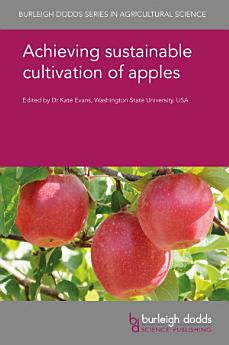Achieving sustainable cultivation of apples
About this ebook
Drawing on an international range of expertise, this collection focuses on ways of improving the cultivation of apples as a food crop at each step in the value chain, from breeding through to post-harvest storage. The book first reviews research in apple physiology and breeding. The following sections focus on cultivation techniques through to post-harvest storage, followed by a discussion of diseases and pests and their management. Concluding chapters address wider issues such as economics, consumer trends and sustainability.
Achieving sustainable cultivation of apples will be a standard reference for fruit and horticultural scientists in universities, government and other research centres and companies producing apples.
About the author
Dr Kate Evans is Professor of Horticulture at the Tree Fruit Research and Extension Center at Washington State University, USA.
Gerry Neilsen obtained his PhD.in Soils Science at McGill University in Montreal in 1977 and has worked at PARC-Summerland and at the national Soil Research Institutes in Ottawa and Aberdeen Scotland as well as with the Ontario Ministry of Agriculture in Guelph Ontario in a research career spanning 37 years. Since his retirement in 2015 he has been an Honorary Research Associate at Summerland. At the Pacific Agriculture Research Centre in Summerland he has investigated soil and nutrient management strategies for intensive horticultural production systems including vegetables, temperate tree fruits and grapes. He has authored or co-authored 160+ scientific manuscripts.
Dr. Manoj Karkee is an Associate Professor in the Biological Systems Engineering Department and the Center for Precision and Automated Agricultural Systems at Washington State University (WSU). He has published extensively in journals such as Computers and Electronics in Agriculture, and the Transactions of the ASABE and has been an invited speaker at several national and international conferences. Dr. Karkee is currently serving as an associate editor for Transactions of the ASABE, editorial board member for Image Processing in Agriculture, and editorial advisory board member of Computers and Electronics in Agriculture.
Professor Chris Watkins is Herman H. Cohn Professor of Horticulture and Associate Dean at Cornell University and Director of Cornell Cooperative Extension. An internationally-renowned expert on postharvest physiology, and a Fellow of the American Society for Horticultural Science. He is the current Chair of the International Society for Horticultural Science (ISHS) Division for Postharvest and Quality Assurance, and a member of the editorial board of the journal Postharvest Biology and Technology.







